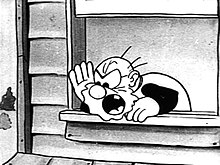Farmer Al Falfa
| Farmer Al Falfa | |
|---|---|
 Farmer Al Falfa in "The Iron Man" (1930) | |
| Created by | Paul Terry |
| In-universe information | |
| Alias | Farmer Alfalfa and Farmer Gray (alternative names) |
| Species | Human |
| Gender | Male |
| Occupation | Farmer |
Farmer Al Falfa, also known as Farmer Alfalfa,[1] is an animated cartoon character created by American cartoonist Paul Terry. He first appeared in Down On the Phoney Farm (1915), a short Terry cartoon distributed by the Thanhouser Company. Next came a series of shorts produced by Terry for Bray Studios, starting with Farmer Al Falfa's Cat-Tastrophe (1916).[2]
After leaving Bray, Terry retained the character, making new shorts for Edison and Paramount over the few years following. Terry then used Farmer Al Falfa frequently during the 1920s for his
In 1929, Terry left his producer,
For roughly a year, the farmer continued to appear in Van Beuren's cartoons, now being made by former Terry associates John Foster and Mannie Davis (both of whom would rejoin Terry a few years later). Terry threatened legal action against his former producer, as the character was established as his own property, not Van Beuren's; the farmer stopped appearing in Van Beuren's films. As Terry's studio began to grow and develop, Farmer Al Falfa wore out his welcome and was subsequently all but retired. The Farmer never entirely disappeared, though; he was featured as a supporting player in the first two Heckle and Jeckle cartoons, released in 1946, and starred in Uranium Blues (1956) ten years later.
In the fall of 1958, the white-bearded protagonist starred in the syndicated television program Farmer Al Falfa and his Terrytoon Pals, a compilation of the earlier black and white Terry shorts. Though no longer for sale in the mainstream television market, most of the early cartoons, the silents in particular, have surfaced on public domain compilations including, most notably, Video Yesteryear's Cartoonal Knowledge VHS series from the 1980s.
In the early 1950s, the character was unofficially rechristened "Farmer Gray", probably by Fred Sayles, the host of a children's program called Junior Frolics on station WATV in Newark, New Jersey. Sayles certainly named some of the subsidiary characters (presumably previously nameless), e.g., "Bumpy" the donkey, "Casper" and "Bad Mike", the cats, and "Marty" and "Millie", the mice.
In mid-1950s Terrytoons comics, the character was also briefly rechristened "Farmer Gray", presumably in an effort to capitalize on "Junior Frolics", but the renaming in comics did not last; it was done inconsistently (sometimes changing from month to month), and by the late 1950s, the character's original name was back permanently.
Farmer Al Falfa was going to have a cameo in Who Framed Roger Rabbit, alongside other Terrytoons characters such as Mighty Mouse, Heckle and Jeckle, and others, but rights to the character could not be obtained in time.[citation needed]
See also
References
- ^ Farmer Alfalfa at Don Markstein's Toonopedia. Archived from the original on June 27, 2016. Source notes: "Al (whose name later became Farmer Alfalfa, one word, as evidenced by occasional sightings of it spelled out on screen)...."
- ISBN 0-8160-3831-7. Retrieved 6 June 2020.
- ISBN 0-8160-3831-7. Retrieved 6 June 2020.
- Crafton, Donald (1993): Before Mickey: The Animated Film, 1898-1928. University of Chicago Press.
- Maltin, Leonard (1987): Of Mice and Magic: A History of American Animated Cartoons. Penguin Books.
External links
- Farmer Al Falfa at the Internet Movie Database
